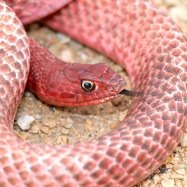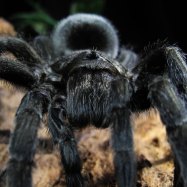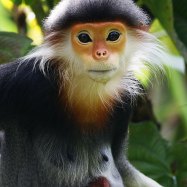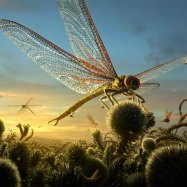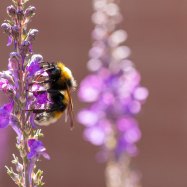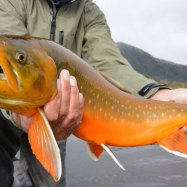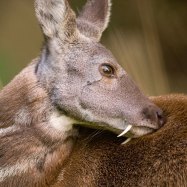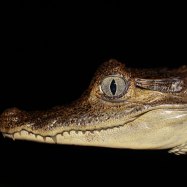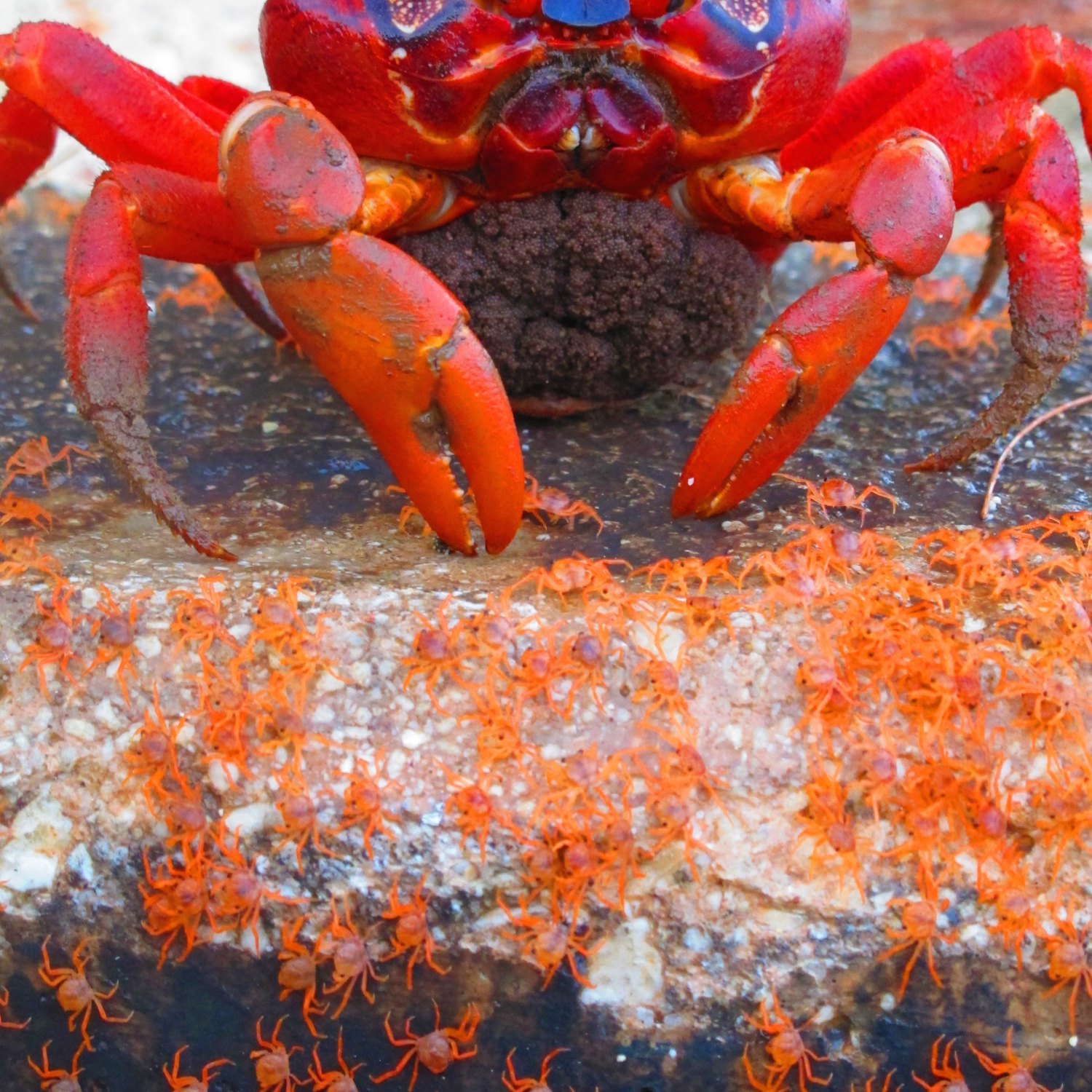
Christmas Island Red Crab
About 11 cm (4.3 in)
The Christmas Island Red Crab, found on the remote Christmas Island in the Indian Ocean, is an iconic sight during their annual mass migration. These fascinating creatures, with their bright red shells and long, spindly legs, can grow up to 11 cm long. They belong to the Gecarcinidae family and have a broad carapace, making them perfect climbers. Keep an eye out for these colorful crabs on your next trip to Christmas Island!
Animal Details Summary:
Common Name: Christmas Island Red Crab
Kingdom: Animalia
Habitat: Terrestrial
The Fascinating World of the Christmas Island Red Crab: A Unique and Colorful Species
Christmas Island, a remote island located in the Indian Ocean, is home to a unique and vibrant species of crab – the Christmas Island Red Crab. Scientifically known as Gecarcoidea natalis, this species has captured the hearts and minds of researchers and nature enthusiasts alike, with its bright red coloration and intriguing behavior. In this article, we will delve into the world of these magnificent creatures and uncover the secrets that make them truly one of a kind.A Unique Classification
The Christmas Island Red Crab belongs to the Animalia kingdom, which includes all living organisms that are capable of self-sustaining and reproduction Christmas Island Red Crab. Within this kingdom, it belongs to the phylum Arthropoda, which consists of invertebrate animals with jointed limbs and a hard exoskeleton. This species falls under the class Malacostraca, which encompasses over 40,000 species of crustaceans such as crabs, lobsters, and shrimps. Additionally, it is part of the order Decapoda, which translates to "ten feet" in Latin, referring to their ten legs. This order also includes other well-known species such as the Dungeness crab and the blue crab.A Delicate Habitat
The Christmas Island Red Crab is a terrestrial species, meaning it lives on land, unlike other crabs that reside in water bodies. This makes it unique and sets it apart from other crustaceans. Its habitat is limited to the small Christmas Island, located approximately 2,600 kilometers off the coast of Australia. This island is the sole natural habitat of the Christmas Island Red Crab, making it a crucial part of the island's ecosystem.A Diverse Diet
As omnivorous creatures, the Christmas Island Red Crab feeds on a wide variety of plants, fruits, and even small animals Cochin Chicken. They play a vital role in the island's ecosystem by controlling the population of plants and animals, thereby maintaining a healthy balance. These crabs are also known to be scavengers, feeding on carcasses and other organic matter found on the forest floor.The Center of Attention
One of the most fascinating aspects of the Christmas Island Red Crab is its unique reproductive behavior. Every year, during the wet season, millions of crabs undergo a mass migration from the forests to the beaches to breed. This migration, known as the 'red crab migration,' is a spectacular sight to behold, attracting tourists and researchers from all over the world.The Journey of a Lifetime
The migration of the Christmas Island Red Crab is an incredible feat of nature. It starts with the adult crabs gathering near the entrance of their burrows, waiting for the signal to embark on their journey. The males lead the way, followed by females, and finally, the juveniles. They make their way through the forests, across roads, and over rocks, covering a distance of up to 8 kilometers to reach the beaches.A Threatening Journey
The journey of the Christmas Island Red Crab is not without its challenges. Along the way, they face numerous obstacles, including predators such as birds, reptiles, and other crabs. To protect themselves, they travel in large groups, making it difficult for predators to attack. Additionally, the red color of their carapace serves as a warning to potential predators, signaling that they are poisonous.Breeding on the Beaches
Once the crabs reach the beaches, the males dig burrows in the sand while the females await their arrival. The males display their strength and prowess by fighting with their claws and competing for mating rights. Finally, the females select their mates, and the breeding process takes place. During this time, the male crabs also construct small mud mounds near the burrows for the females to lay their eggs.The Next Generation
After the breeding process, the female crabs carry the fertilized eggs for two weeks, after which they release them into the ocean. The eggs hatch into tiny larvae, which undergo several stages of development before returning to the island as adults, completing their life cycle.Natural Protection
The Christmas Island Red Crab has a vibrant red color, which is a noteworthy feature of this species. This bright coloration plays an essential role in the crab's survival, as it serves as a natural defense mechanism against predators. The vivid red pigment is a result of carotenoids, which are organic pigments found in plants. The crabs consume these carotenoid-rich plants, giving them their unique color.A Perfectly Adapted Species
The body of the Christmas Island Red Crab is perfectly adapted to survive in its terrestrial habitat. Unlike other crabs, they have long and slender legs that allow them to move quickly on land. Their broad carapace protects their vital organs, and their sharp claws are useful for digging burrows and fighting off predators. Additionally, they have gills that are adapted to absorb moisture from the air, allowing them to survive in dry conditions.A Conservation Concern
The Christmas Island Red Crab is vital to the health of the island's ecosystem, making it a conservation priority. However, their population has been on the decline due to various threats, such as climate change, habitat destruction, and invasive species. Conservation efforts, such as protecting their breeding grounds and controlling the number of invasive species, are crucial to preserving this unique species for future generations.Conclusion: A Christmas Island Treasure
In conclusion, the Christmas Island Red Crab is a truly remarkable and fascinating species. From its bright red color to its unique reproductive behavior, it captivates the minds of all who encounter it. Its journey during the mass migration is a testament to the resilience and adaptability of this species, making it a symbol of Christmas Island and its diverse ecosystem. As stewards of the environment, it is our responsibility to protect and preserve this extraordinary species and its delicate habitat, ensuring that it continues to thrive for generations to come.

Christmas Island Red Crab
Animal Details Christmas Island Red Crab - Scientific Name: Gecarcoidea natalis
- Category: Animals C
- Scientific Name: Gecarcoidea natalis
- Common Name: Christmas Island Red Crab
- Kingdom: Animalia
- Phylum: Arthropoda
- Class: Malacostraca
- Order: Decapoda
- Family: Gecarcinidae
- Habitat: Terrestrial
- Feeding Method: Omnivorous
- Geographical Distribution: Christmas Island
- Country of Origin: Australia
- Location: Christmas Island, Indian Ocean
- Animal Coloration: Bright red
- Body Shape: Broad carapace with long legs
- Length: About 11 cm (4.3 in)
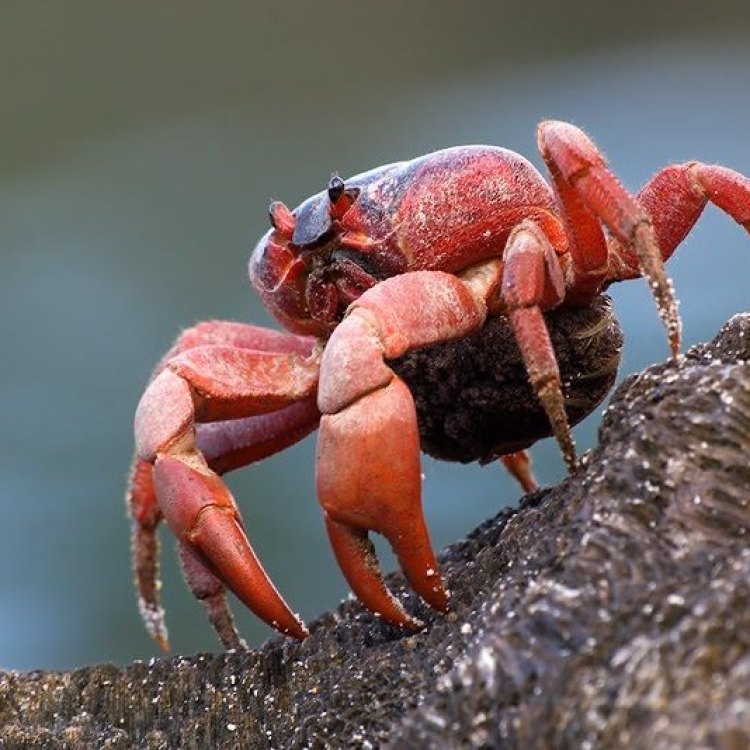
Christmas Island Red Crab
- Adult Size: About 11 cm (4.3 in)
- Average Lifespan: Up to 20 years
- Reproduction: Sexual
- Reproductive Behavior: Mass synchronous spawning
- Sound or Call: No known sounds or calls
- Migration Pattern: Annual migration to the sea for breeding
- Social Groups: Solitary
- Behavior: Active during the day
- Threats: Habitat loss, invasive species
- Conservation Status: Not evaluated
- Impact on Ecosystem: Important for nutrient cycling
- Human Use: Not a significant human use
- Distinctive Features: Bright red coloration, long legs, large claws
- Interesting Facts: The Christmas Island Red Crab is famous for its annual migration, where millions of crabs move from the forest to the shore to breed.
- Predator: Monitor lizards, birds, and introduced rats
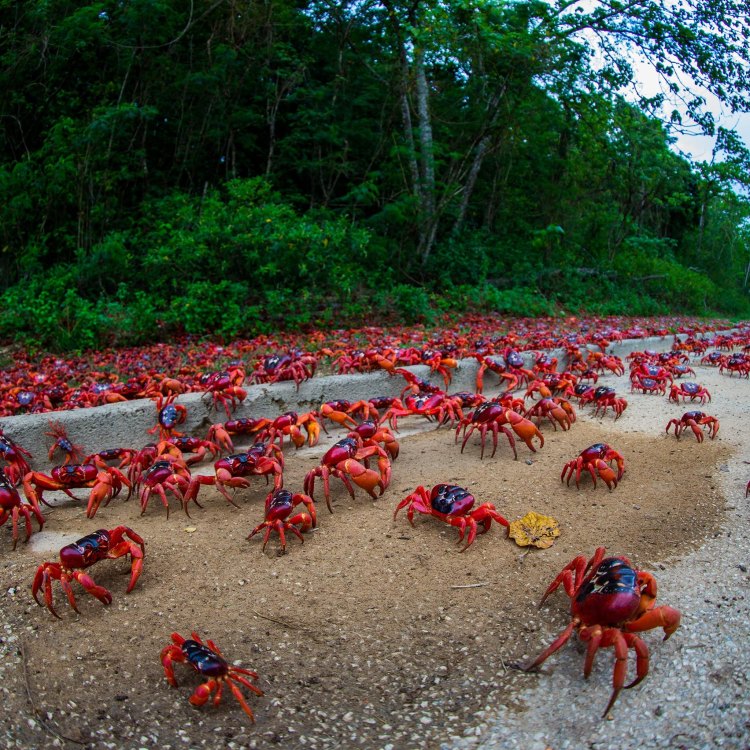
Gecarcoidea natalis
The Incredible Story of the Christmas Island Red Crab: An Annual Journey of Survival
In the vast and vibrant blue waters of the Indian Ocean, lies a remote tropical island known as Christmas Island. And while the island may be famous for its stunning beaches and tropical rainforests, it is the annual migration of the Christmas Island Red Crab that truly captures the world's attention.Found only on this island, the Christmas Island Red Crab (Gecarcoidea natalis) is a species of freshwater crab that is truly one of a kind. With its bright red coloration, long legs, and large claws, it is a visually striking creature PeaceOfAnimals.Com. But what truly sets this crab apart is its remarkable journey of survival that takes place every year.
Let's dive into the incredible story of the Christmas Island Red Crab and uncover the unique features and behaviors of this fascinating crustacean.
A Unique Species
The Christmas Island Red Crab is a relatively small crab, growing to a maximum size of about 11 cm (4.3 in). What it lacks in size, it makes up for in its vibrant red coloration, making it a standout in the lush green rainforest where it resides.This species has an average lifespan of up to 20 years, making it a long-lived species compared to other crabs. It is also a solitary creature, meaning it prefers to live and hunt alone. However, during their annual migration, these crabs come together in massive numbers, creating an incredible sight for onlookers.
The Annual Migration
Every year, between October and November, when the rainy season begins, the Christmas Island Red Crabs embark on a remarkable journey Caribou. Millions of crabs cover the forest floor as they make their way from the forest to the ocean to breed.This annual migration is a critical behavior for the survival of this species. Female crabs release their eggs into the ocean, where they will develop into larvae and be carried away by ocean currents. After a few weeks, the larvae will return to the island, completing the life cycle of the Christmas Island Red Crab.
Mass Synchronous Spawning
What makes the Christmas Island Red Crab's reproduction even more unique is their mass synchronous spawning behavior. This means that all the female crabs release their eggs into the ocean at the same time, which significantly increases the chances of successful fertilization and survival of their offspring.This behavior is crucial for the species, as it ensures the survival of the entire population. If the crabs were to release their eggs at different times, the larvae might not survive the harsh ocean conditions, and the population could dwindle.
The Importance of Nutrient Cycling
Aside from their fascinating annual migration, the Christmas Island Red Crabs play a significant role in the ecosystem of Christmas Island. They are responsible for an essential process called nutrient cycling, where they consume fallen leaves and fruits from the forest floor and then redistribute those nutrients back into the soil through their waste.This action helps to nourish the soil and promote the growth of vegetation, making the rainforest a healthier and more balanced ecosystem. Without the Christmas Island Red Crabs, the island's ecosystem could suffer greatly.
Threats to the Christmas Island Red Crab
Despite their critical role in the ecosystem, the Christmas Island Red Crab's population has been significantly impacted by various threats. One of the most significant threats to their survival is habitat loss caused by human activities, such as land development and deforestation.Invasive species, like the introduced yellow crazy ant, also pose a threat to the Christmas Island Red Crab. These ants have been known to attack and kill young crabs, disrupting their life cycle and population growth.
Conservation Efforts
The conservation status of the Christmas Island Red Crab is currently not evaluated by the International Union for Conservation of Nature (IUCN). However, the island's government has taken steps to protect this species and its habitat.Christmas Island National Park, which covers two-thirds of the island, is a protected area where these crabs can thrive. The park also has strict rules in place to protect the crabs during their annual migration, including road closures and speed limits for vehicles.
Predators and Human Use
The Christmas Island Red Crab does not have many natural predators on the island. However, they are sometimes hunted by monitor lizards and birds. But the most significant threat to their survival comes from introduced species, such as rats, cats, and dogs, which prey on the crabs and their eggs.In terms of human use, the Christmas Island Red Crab has no significant economic value. They are not commercially harvested, and there are no cultural or traditional uses for this species.
Interesting Facts About the Christmas Island Red Crab
Aside from its annual migration, there are many interesting facts about the Christmas Island Red Crab that make it a unique and fascinating species.- The Christmas Island Red Crab is known as the "little red crab" in the local language, reflecting the island's name (Christmas Island).
- These crabs are extremely active during the day, making loud rustling noises as they move through the forest.
- They have no known sounds or calls, making them one of the few species of crabs that do not make any vocalizations.
- The Christmas Island Red Crab is the subject of an annual festival on Christmas Island, where visitors can witness their incredible migration.
- This species has been featured on several stamps and coins in Australia, highlighting its importance and uniqueness.
The Future of the Christmas Island Red Crab
The Christmas Island Red Crab is a truly remarkable species, with its bright red coloration, unique behaviors, and incredible annual migration. However, the future of this species is uncertain, with ongoing threats to its survival.It is essential for us to continue to protect and preserve the island's habitat for these crabs to thrive. And as visitors, we must also respect the rules and regulations in place during their annual migration, allowing this species to continue their incredible journey of survival.
In conclusion, the Christmas Island Red Crab is not just a symbol of Christmas Island; it is a symbol of resilience, adaptation, and survival. And as we strive to protect our planet's unique and diverse species, let us remember the incredible story of this small but mighty crab.
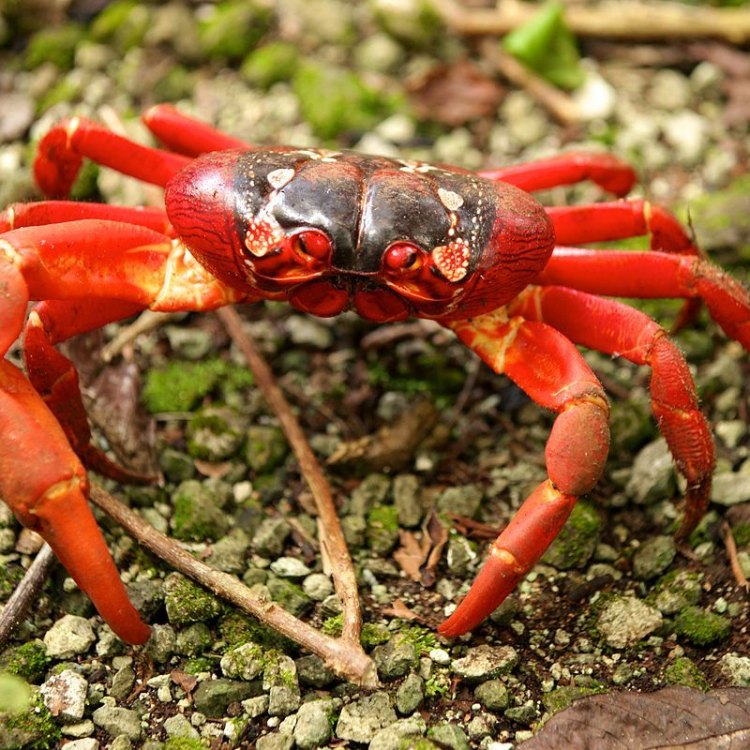
The Fascinating World of the Christmas Island Red Crab: A Unique and Colorful Species
Disclaimer: The content provided is for informational purposes only. We cannot guarantee the accuracy of the information on this page 100%. All information provided here may change without prior notice.

